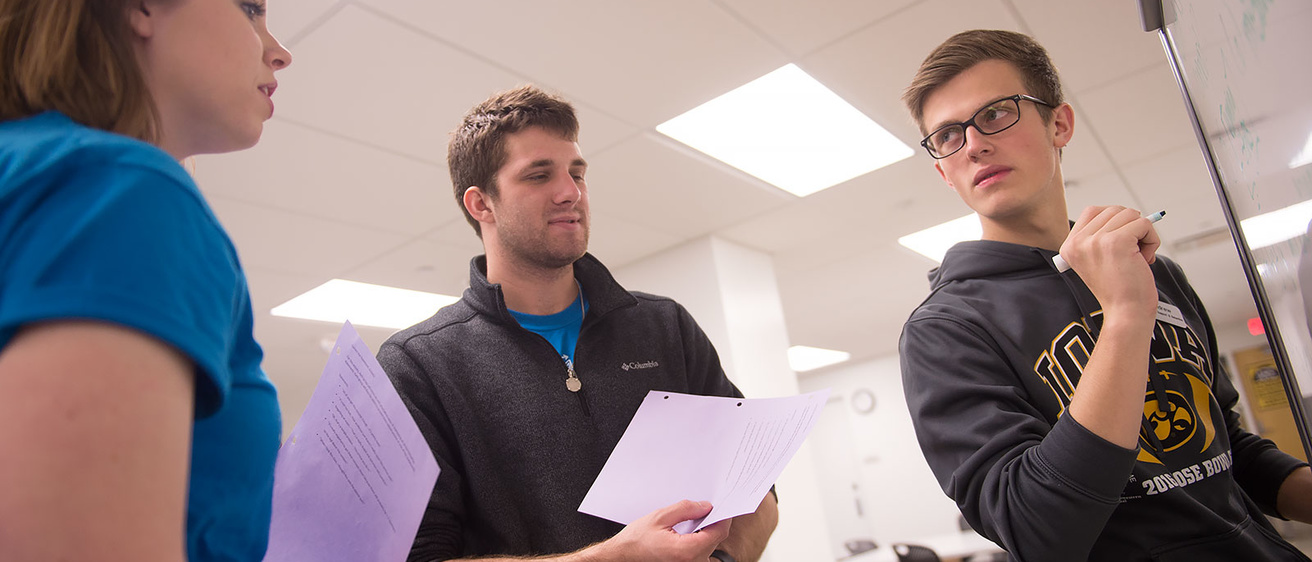Sometimes the best way to understand a difficult concept is to talk about it and hear other points of view.
That’s why the University of Iowa offers extra help to students enrolled in challenging courses historically known for high failure rates and withdrawal, such as General Chemistry I and II, Introductory Animal Biology, and Elementary Psychology. In a free service called Supplemental Instruction, students meet in small groups, participate in collaborative activities, and discuss difficult concepts from class. They compare notes, get organized, and prepare for tests.
Supplemental Instruction by the numbers for Fall 2015177,0001,20022Fun factCourses with SI for Spring 2016:
SI courses, up from 14 in Spring 2015
More than visits to Supplemental Instruction sessions
More than individual students who attended SI sessions, most of whom made multiple visits
SI leaders, up from 16 in Spring 2015.
: Students who participate in SI, regardless of academic preparation in the subject matter, average one letter grade higher than their peers.
Applied Exercise Physiology (HHP:3400)
Biological Psychology (PSY:2701)
Calculus for Biological Sciences (MATH:1460)
College Algebra (MATH:1005)
Diversity of Form & Function (BIOL:1412)
Elementary Psychology (PSY:1001)
Foundations of Biology (BIOL:1411)
General Chemistry I (CHEM:1070)
General Chemistry II (CHEM:1080)
Human Anatomy (HHP:1100)
Human Biology (BIOL:1140)
Introductory Animal Biology (BIOL:1141)
Math for Business (MATH:1340)
Math for Biological Sciences (MATH:1440)
Nutrition & Health (HHP:2310)
Organic Chemistry I (CHEM:2210)
Organic Chemistry II (CHEM:2220)
Principles of Chemistry I (CHEM:1110)
Principles of Chemistry II (CHEM:1120)
Visit the Tutor Iowa website to learn more about Supplemental Instruction or to see the SI session schedule for Spring 2016.SI sessions are free and facilitated by undergraduate peer leaders who have taken the course and understand what it takes to succeed.
Brianna Didriksen, a sophomore in pre-nursing, credits SI with helping her succeed in some of her most challenging courses, including General Chemistry, Principles of Chemistry, and Human Anatomy.
“I decided to go because I struggled in high school with grades, and I wanted to do well in college,” she says. “I don’t understand how anyone passes their classes without going to an SI. They helped me so much.”
Mirra Anson, director of Academic Support and Retention at the UI, says this spring, SI is being offered for 19 undergraduate courses. Students can attend any of the courses’ three 50-minute help sessions held each week at the Academic Resource Center on the ground floor of the Iowa Memorial Union.
“SI leaders facilitate activities that are based on student questions or what was covered that day in class,” Anson says. “The whole idea is to give students time to interact with each other in small groups and talk about content.”
Stephanie Preschel, assistant director in Academic Support and Retention and coordinator of the SI program, says, “SI leaders create a positive and welcoming environment that allows students to discuss course content, regardless of where they are in terms of understanding the material.”
Preschel says research shows that attending a 50-minute SI session is equivalent to students studying on their own for two hours, and students who participate in SI, regardless of academic preparation in that subject matter, receive a letter grade higher than their peers, on average. Students also build peer connections in SI that often lead to outside study groups.
“I met so many different people and made new friends who I am still in contact with today, which is really cool,” Didriksen says.
Supplemental Instruction was developed in 1973 at the University of Missouri–Kansas City as a way to improve student retention and success in traditionally difficult courses. The SI model has been adopted by colleges and universities in the United States and internationally.
At the UI, peer leaders must receive an A in the course to be eligible for the job. All SI leaders attend a two-day training session at the beginning of the semester. After that, they attend all class lectures, take notes, and act as role models to the students they help.
Emily Anson, a senior majoring in biology, attended SI for genetics before becoming a peer leader for the course. Her experience has given her an edge in understanding her students.
“Even though I eventually got an A in the course, it wasn’t like everything came easy to me,” she says. “Peer leaders know what it’s like to struggle through it. We can share with students what helped us to finally understand it.
“We have a unique perspective,” she adds.
Jessa Engelken, a junior majoring in health promotion, says that as an SI peer leader, she sees firsthand how small-group discussions eliminate barriers for students.
“If a student doesn’t understand it one way, they can hear someone explain it another way that might make sense to them,” she says. “It’s all about students working with each other.”
Marco Cuellar, a freshman majoring in human physiology, says he attended SI for General Chemistry because he wanted the extra practice, not because he was struggling in class.
“I knew chemistry was a course where the more problems you practiced, the better you’d be,” he says. “I would recommend SI to other students, especially freshmen, because it puts you on a route to success. Without it, I don’t know if I would have gotten an A because it pushed me to be disciplined with repetition and practice.”
